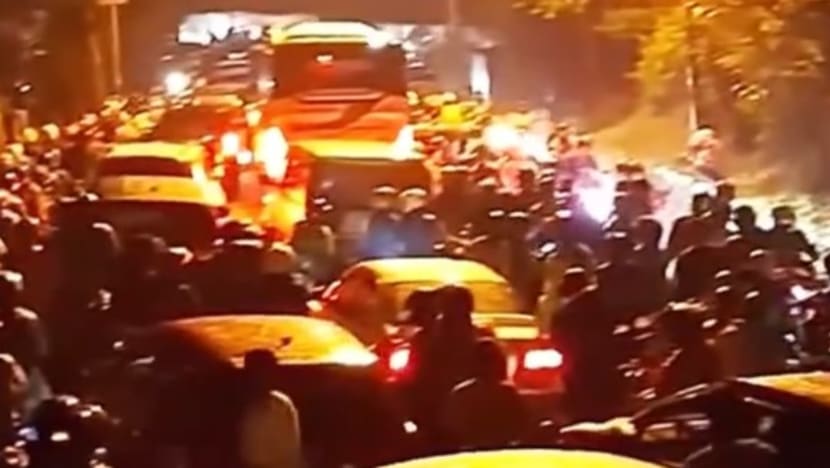‘Horror’ 14-hour long traffic jam: Residents in Indonesia’s West Java aghast at ‘worst’ gridlock amid holiday rush
Photos widely shared on social media showed vehicles bumper to bumper even as motorists turned off their engines and got out to sit or sleep by the roadside, some with sleeping bags in hand.

The traffic congestion in Indonesia's Puncak region in West Java province over the long weekend from Sep 14, 2024 to Sep 16, 2024. (Photo: X/@AIs1to)
BOGOR, Indonesia: In what some local residents tout as the “worst” traffic congestion they had experienced, holiday-goers in the mountainous region of Puncak in Indonesia’s West Java province got more than they bargained for when they found themselves stuck on the road for upwards of 14 hours.
The “horror” gridlock - as coined by Indonesian media - occurred over the long weekend ending on Monday (Sep 16) to commemorate the Prophet Muhammad’s birthday. It was a public holiday in Indonesia.
Photos widely shared on social media showed vehicles bumper to bumper even as motorists turned off their engines and got out to sit or sleep by the roadside, some with sleeping bags in hand.
“We are used to the Puncak traffic jam. But usually it subsides after a few hours. Now I am stuck for about 14 hours. From yesterday afternoon until this morning,” one resident who identified himself as Ade told news outlet Detik on Sep 16.
Another resident named Yuli said it was the “first time in her life” to be caught in traffic for such an extended period of time. In a TikTok post that has since gone viral with over two million views, Ms Yuli said she was stuck in the Puncak traffic congestion from 10am on Sep 15 while on her way to Taman Safari, a famous zoo in Bogor.
“2am (and) still not moving ... 3 am,” said Yuli, who continued to be stuck in the congestion until the morning of Sep 16 and finally cancelled her outing to the zoo.
Commenting on Ms Yuli's post, another Puncak resident claimed that “Sep 15 was the worst traffic jam in the history of Puncak”.
Citing the police, local media reported on Sep 16 that there were a total of 140,000 vehicles crossing the Puncak area, double the maximum number that the two-way road in the area can accommodate.
Puncak - located some 70km from Indonesia’s capital Jakarta - typically experiences normal traffic congestion on weekends lasting two to three hours long due to the large number of tourists from the Greater Jakarta area who visit the region for its famed tea plantations and cool breezes.
It has 22 kilometers of road winding at the foot of Mount Gede-Pangrango from Bogor to Cianjur, West Java. There are also more than 3,500 hotels and over 4,200 villas located in the region.
On weekdays, travellers can get to the region from Jakarta in under two hours.
In addition to the unusually large number of vehicles visiting the area over the long weekend, police quoted by Detik said the congestion was caused by the undisciplined behaviour of motorcyclists who were impatient and went against the flow of traffic.
This then caused the traffic to come to a standstill.
According to Liputan6.com, at least one tourist from East Jakarta died on Sep 15 as a result of the severe traffic congestion in Puncak. The 56-year-old woman was said to be exhausted after being stuck in traffic for nine hours.
Her body had to be moved to a nearby mosque because an ambulance which was called to take her to the hospital was stuck in the traffic as well. However, police denied that the woman died because of the traffic jam, but rather due to her comorbidity.
Since 1986, the police have handled traffic congestions in Puncak during the weekend with a one-way traffic system. However, this method is no longer considered effective.
Various solutions to solve Puncak’s congestion issues are being planned by the government, including the construction of a 51.8km toll road from Bogor to Cianjur which is estimated to cost up to 25 trillion rupiah (US$1.6 billion) and is targeted to be built by 2030.
Another solution is the cable car construction plan proposed by Tourism and Creative Economy Minister Sandiaga Uno in 2022.
In January, Mr Sandiaga was quoted by Detik as saying that the blueprint of the Puncak cable car development had been prepared by a private firm with plans for investments from countries in the Middle East.
However, it is still not known when this project will start and how much it will cost.














